Deboning
Raw Materials: Fresh bangus (preferably 3 pieces to a kilo)
Equipments:
- Mosquito forceps, straight
- Cutting board
- Sharp knife
- Utility tray
- Basin
Pre-Preparation
1. Washing. Wash fish upon arrival from the market. Scales may or may not removed.
2. Splitting. Split fish on the dorsal side starting from the tail to the head by running the edge of the knife along the backbone.
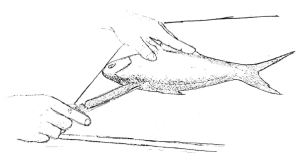
3. Removal of internal organs. Lay fish open like butterfly fillet. Remove gills and internal organs. Wash fish to remove blood and dirt. The black membrane covering the belly cavity may or may not be removed depending upon the consumers choice. Wash fish in running water.

4. Removal of backbone dorsal fin. Remove backbone by laying fish flat on the cutting board with the skin down. Hold the knife in a horizontal/slanting position and cut in with the tip of the blade along the backbone from the head to tail. Trim off the dorsal fin.
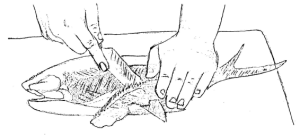
Deboning Proper

3. Removal of internal organs. Lay fish open like butterfly fillet. Remove gills and internal organs. Wash fish to remove blood and dirt. The black membrane covering the belly cavity may or may not be removed depending upon the consumers choice. Wash fish in running water.

4. Removal of backbone dorsal fin. Remove backbone by laying fish flat on the cutting board with the skin down. Hold the knife in a horizontal/slanting position and cut in with the tip of the blade along the backbone from the head to tail. Trim off the dorsal fin.

Deboning Proper
It is important to know the exact location of the spines most especially the the intermascular spines.
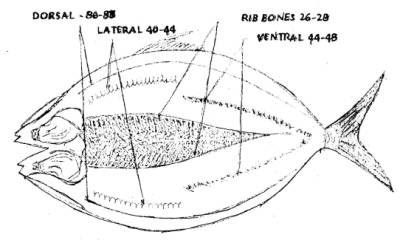
Total number of spines 196-208. Place fish in the shallow tray. With the end of the mosquito forceps, start removing the spines.

1. Rib bones. The bones are located in the belly cavity. They are visible and superficially embedded thus easy to pull out.
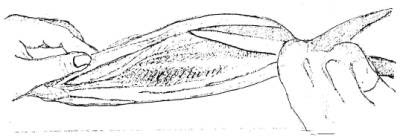
2. Dorsal intermascular spines. Make a superficial slit from head to tail along the dent of the dorsal muscle. Pull out the embedded intermascular spines one at a time.

The spines on the head portion are branched spines while the rest are unbranched. The spines on the tail portion are very much attached to the muscle tendon, making it difficult to remove. It is necessary to make a horizontal slit on this portion for easier removal of these spines.
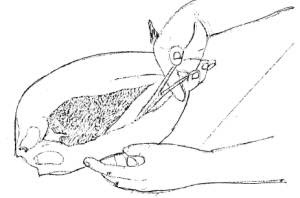
3. Lateral intermascular spines. Area located in-between the dorsal and ventral muscles. Pull out first the large arch-shaped spines at the base of the operculum. Proceed puling out the Y-shaped spines up the mid-portion of the body ending with 3 single delicate spines.

4. Ventral intermascular spines. Make a shallow slit along the dent between the muscle segments of the ventral side and mid-portion of the body to the tip of the muscle in the tail. Pull out the first 2 very fine and delicate spines found in the mid-body which is the start of the spines located in this portion. Proceed to the tail region.

Total number of spines 196-208. Place fish in the shallow tray. With the end of the mosquito forceps, start removing the spines.

1. Rib bones. The bones are located in the belly cavity. They are visible and superficially embedded thus easy to pull out.

2. Dorsal intermascular spines. Make a superficial slit from head to tail along the dent of the dorsal muscle. Pull out the embedded intermascular spines one at a time.

The spines on the head portion are branched spines while the rest are unbranched. The spines on the tail portion are very much attached to the muscle tendon, making it difficult to remove. It is necessary to make a horizontal slit on this portion for easier removal of these spines.

3. Lateral intermascular spines. Area located in-between the dorsal and ventral muscles. Pull out first the large arch-shaped spines at the base of the operculum. Proceed puling out the Y-shaped spines up the mid-portion of the body ending with 3 single delicate spines.

4. Ventral intermascular spines. Make a shallow slit along the dent between the muscle segments of the ventral side and mid-portion of the body to the tip of the muscle in the tail. Pull out the first 2 very fine and delicate spines found in the mid-body which is the start of the spines located in this portion. Proceed to the tail region.
Courtesy of EntrePinoys, Atbp.
No comments:
Post a Comment